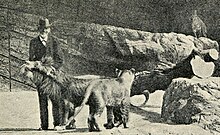カール・ハーゲンベック
カール・ハーゲンベック | |
|---|---|
 | |
| 生誕 |
1844年6月10日 |
| 死没 |
1913年4月14日(68歳没) |
| 国籍 |
|
| 著名な実績 | ハーゲンベック=ウォレス・サーカス、ハーゲンベック動物園 |
| 親 | Claus Gottfried Carl Hagenbeck |



カール・ハーゲンベック(Carl Hagenbeck、1844年6月10日 - 1913年4月14日)は、野生動物を扱うドイツ人商人で、ヨーロッパ各地の動物園やP・T・バーナムのサーカスなどに動物を提供していた[1]。無柵放養式展示の近代的動物園を作った[2]。ハーゲンベック動物園は個人経営の動物園としてはドイツで最も成功を収め、1907年にはハンブルクに常設された。動物と同じように人間を展示する人間動物園も興行したことがある。
生涯
[編集]1844年6月10日、ハンブルクで魚屋を営む父の下に生まれる。父は魚屋の傍ら、野生動物の売買も行っていた[3]。
14歳のとき、父からアシカとホッキョクグマを与えられた[3][4]。その後も彼の動物コレクションは増え続け、飼うために大きな建物が必要となった。やがてハンブルクの実家を出て、狩猟家や冒険家と共にジャングルや雪をかぶった山に分け入るようになった。そして世界中の様々な土地で動物を捕まえた。1874年、サモア人とサーミ人(当時は差別的に「ラップランド人」と呼ばれた)を「文明に汚されていない」人種として展示・興行することを思い立ち、人間に加えて彼らのテント、武器、ソリ、トナカイなどを展示した[5][6]。
1875年、ヨーロッパやアメリカ合衆国の主要都市で彼の集めた動物の展示・興行を開始した。
1876年、協力者をスーダンに派遣して野生動物を持ってこさせ、さらにヌビア人も連れてこさせた。ヌビア人の展示興行はヨーロッパで大成功し、パリ、ロンドン、ベルリンを巡業した。カナダのラブラドール地方にも人を派遣し、ホープデイルから「エスキモー」(イヌイット)を数名連れてこさせた。イヌイットはハーゲンベック動物園で展示した[5]。「未開」の「野蛮人」と見なされた民族を展示するというハーゲンベックの手法は、アルベルト・ジョフロア・ド・サンヒレアに「人間動物園」の着想を与え、パリのジャルダン・ダクリマタシオンで同様の展示が行われることになった。サンヒレアは1877年にイヌイットとヌビア人の民族学的展示を行い、同動物園の入場者数が倍増した[5]。
ハーゲンベックは野生動物を調教し、イリノイ州シカゴで開催された万国博覧会(1893年)やセントルイスで開催された万国博覧会(1904年)で興行し、同時にサーカス興行主に販売した。ハーゲンベックのサーカスはそれらの万博で最も人気を博した。彼のコレクションには大型の動物や爬虫類も含まれており、様々な動物を調教して芸を仕込んだ。1900年、メスのライオンとオスのベンガルトラを交配させて雑種を作り、それをポルトガルの動物学者 Bisiano Mazinho に200万ドルで売っている。ハーゲンベックの調教した動物は、1914年以前にニューヨークのコニーアイランドにあった遊園地でも芸を披露している。
1905年、動物収集家としての卓越した技能を生かし、千頭ほどのラクダをドイツ帝国がアフリカで活用するために捕らえた。1908年、自身の冒険や動物の捕らえ方や調教技法を本にまとめ、Beasts and Men と題して出版した。
ハーゲンベックは動物をその生息環境に近い環境で恒久的に展示することを夢見ていた。ハンブルクには既にハンブルク動物園があったが、1907年、ハンブルク近郊のStellingenに初の無柵放養式展示のハーゲンベック動物園を作った[4]。1909年から1910年にかけて、ローマでの動物園建設を指導した。今では多くの大規模動物園が彼の展示方式を採用している。
1913年4月14日、ハンブルクで毒蛇のブームスラングに咬まれて死去[1]。
画像
[編集]-
1871年頃の写真
-
サーカス全容(模型)
-
サーカスのポスター(Adolph Friedländer作)
-
ハーゲンベックによるサーミ人の展示を知らせるポスター(ハンブルク)
脚注
[編集]- ^ a b “Carl Hagenbeck. Famous Animal Dealer and Exhibitor Dies in Hamburg.”. New York Times. (April 14, 1913) 2008年7月22日閲覧. "Carl Hagenbeck, the animal collector and senior partner of the ... menagerie and park at Stellingen, near Hamburg died to-day."
- ^ “Hagenbeck Tierpark und Tropen-Aquarium”. Zoo and Aquarium Visitor. 2008年7月22日閲覧。 “カール・ハーゲンベックは誰も考えもしなかったものを作り上げた。1907年、このハンブルク生まれの男は世界初の柵のない動物園を開園。この魚屋の息子は、19世紀末には早くも動物を檻に入れずに開放的な囲いに入れて展示することを考えていた。彼は見物客からは見えない溝で動物と客を分離することを考えた。ハーゲンベックは1896年にそのアイデアの特許を取得した。9年後、その夢はハンブルクで実現。その開放的な眺めは専門家には嘲笑されたが、一般大衆は息を呑んだ。ハーゲンベックの動物園は、今日のサファリパークへの道を切り拓いたと考えられる。”[リンク切れ]
- ^ a b 46;Nigel Rothfels, Savages and Beasts: The Birth of the Modern Zoo. (Baltimore: The Johns Hopkins University Press, 2002)
- ^ a b Chisholm (1911)
- ^ a b c Human Zoos, by Nicolas Bancel, Pascal Blanchard and Sandrine Lemaire, in Le Monde diplomatique, August 2000 French
- ^ Savages and Beasts - The Birth of the Modern Zoo, Nigel Rothfels, Johns Hopkins University Press
参考文献
[編集]Chisholm, Hugh, ed. (1911). . Encyclopædia Britannica (英語) (11th ed.). Cambridge University Press.
- Carl Hagenbeck, Beasts and men. Being Carl Hagenbeck's experiences for half a century among wild animals. (London & New York: Longmans, Green, and Co., 1912).
- Eric Ames, Carl Hagenbeck's Empire of Entertainments (Seattle and London: University of Washington Press, 2009)
- Edward Alexander, “Carl Hagenbeck and His Stellingen Tierpark: The Moated Zoo,” in: Edward Alexander, Museum Masters: Their Museums and Their Influence. (Nashville: American Association for State and Local History, 1983), pp. 311–340.
- Herman Reichenbach, “A Tale of Two Zoos: The Hamburg Zoological Garden and Carl Hagenbeck’s Tierpark,” in: R. J. Hoage and William A. Deiss, eds. New Worlds, New Animals. (Baltimore: Johns Hopkins University Press, 1996), pp. 51–62.
- Nigel Rothfels, Savages and Beasts: The Birth of the Modern Zoo. (Baltimore: The Johns Hopkins University Press, 2002).
- Reptiles of the world by Raymond L. Ditmar talks about him capturing most of the Gavhrials found on exhibit.
Spartaco Gippoliti 2004 Carl Hagenbeck's plan for Rome Zoo - and what became of it. Int. Zoo News 51: 24-28.
関連項目
[編集]外部リンク
[編集]- Karl Hagenbeck: Von Tieren und Menschen. Ausgabe von 1909. Digitalisat der University of Toronto.



